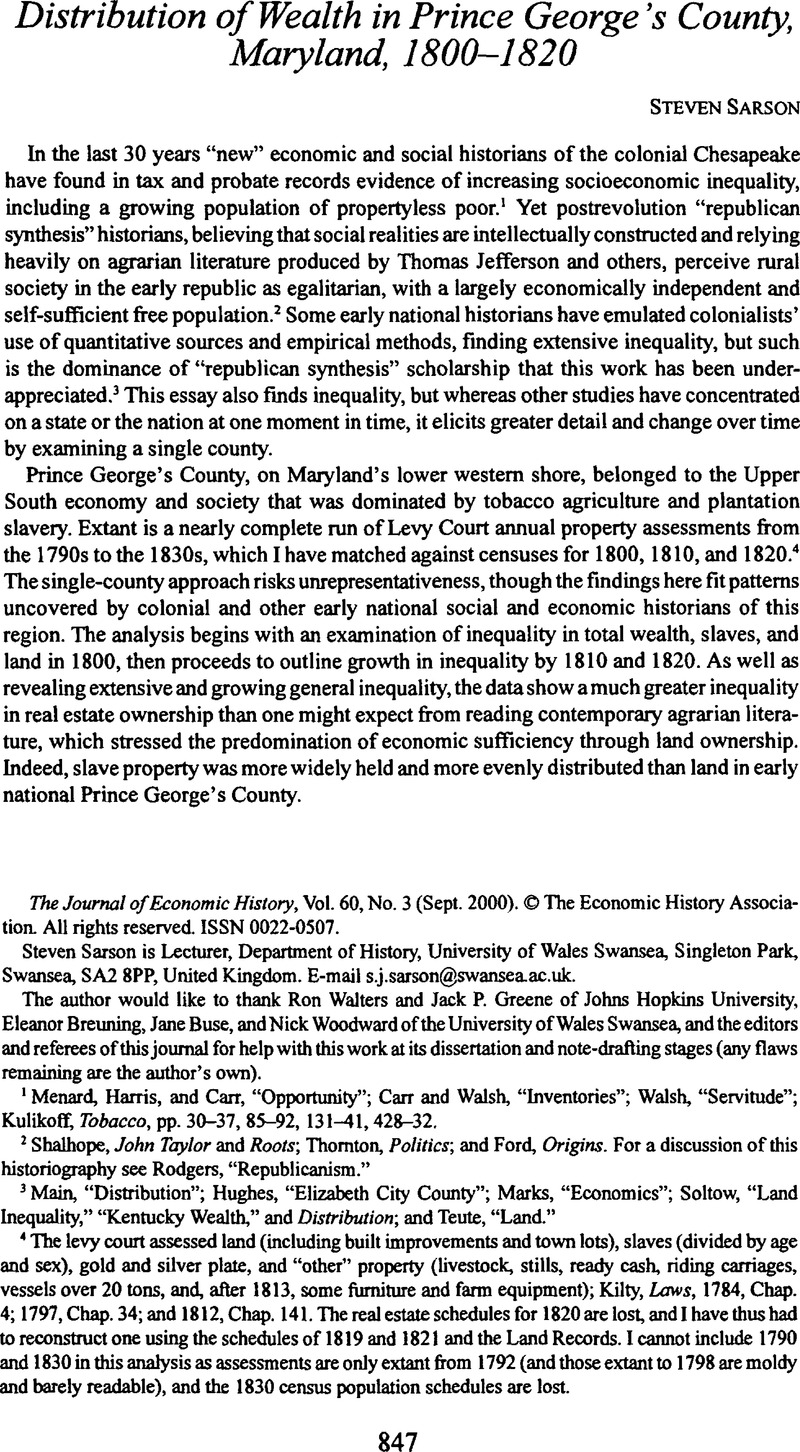No CrossRef data available.
Article contents
Distribution of Wealth in Prince George's Country, Maryland, 1800–1820
Published online by Cambridge University Press: 26 July 2012
Abstract
An abstract is not available for this content so a preview has been provided. Please use the Get access link above for information on how to access this content.

- Type
- Notes and Discussion
- Information
- Copyright
- Copyright © The Economic History Association 2000
References
REFERENCES
Campbell, Randolph B. “Planters and Plain Folks: The Social Structure of the Antebellum South”. In Interpreting Southern History: Historiographical Essays in Honor of Sanford W Higginbotham, edited by Boles, John B. and Nolen, Evelyn Thomas, 48–77. Baton Rouge: Louisiana State University Press, 1987.Google Scholar
Carr, Lois Green. “County Government in Maryland, 1689–1709”. Ph.D. diss., Harvard University, 1968.Google Scholar
Carr, Lois Green, and Walsh, Lorena S.. “Inventories and the Analysis of Wealth and Consumption Patterns in St. Mary's County, Maryland, 1658–1777”. Historical Methods 13, no. 1 (1980): 81–104;CrossRefGoogle Scholar
Earle, Carville V.Evolution of a Tidewater Settlement System: All Hallow's Parish, Maryland, 1650–1783. Chicago: University of Chicago, Department of Geography Research Papers, 1975.Google Scholar
Ford, Lacy K. Jr, Origins of Southern Radicalism: The South Carolina Upcountry, 1800–1860. New York: Oxford University Press, 1988.Google Scholar
Hughes, Sarah Shaver. “Elizabeth City County, Virginia, 1782–1810: The Economic and Social Structure of a Tidewater County in the Early National Years. Ph.D. diss., College of William and Mary, 1975.Google Scholar
Kilty, William.Laws of Marylana 1776–1818, Revised and Collected under the Authority of the Legislature. Annapolis: Maryland State Papers, 1820.Google Scholar
Kulikoff, Allan.Tobacco and Slaves: The Development of Southern Cultures in the Chesapeake, 1680–1800. Chapel Hill: University of North Carolina Press, 1986.Google Scholar
Main, Jackson Turner “The Distribution of Property in Post-Revolutionary Virginia”. Mississippi Valley Historical Review 41, no. 2 (1954): 241–58.CrossRefGoogle Scholar
Marks, Bayly Ellen. “Economics and Society in a Staple Plantation System: St. Mazy's County, Maryland, 1790–1840”. Ph.D. diss., University of Maryland, 1979.Google Scholar
Marks, Bayly Ellen. “The Rage for Kentucky: Emigration from St. Mazy';s County, Maryland, 1790–1810”. In Geographical Perspectives on Maryland's Past, edited by Mitchell, Robert D. and Muller, Edward K., 108–28. University of Maryland Occasional Papers in Geography, 4 (1979).Google Scholar
Menard, Russell R.Economy and Society in Early Colonial Maryland. New York: Garland Press, 1985.Google Scholar
Menard, Russell R., Harris, P. M. G., and Carr, Lois Green. “Opportunity and Inequality: The Distribution of Wealth on the Lower Western Shore of Maryland, 1638–1705”. Maryland Historical Magazine 69, no. 2 (1974): 169–84.Google Scholar
Papenfuse, Edward C. Jr, “Planter Behavior and Economic Opportunity in a Staple Economy”. Agricultural History 46, no. 2 (1972): 297–312.Google Scholar
Rodgers, Daniel T. “Republicanism: The Career of a Concept”. Journal of American History 79, no. 1 (1992): 11–38.CrossRefGoogle Scholar
Sarson, Steven “Wealth, Poverty, and Labor in the Tobacco Plantation South: Prince George's County, Maryland, in the Early National Era”. Ph.D. diss., Johns Hopkins University, 1998.Google Scholar
Sarson, Steven “Landlessness and Tenancy in Early National Prince George's County, Maryland”. William and Mary Quarterly, 3rd Series, 57, no. 3 (2000): 569–98.CrossRefGoogle Scholar
Shalhope, Robert E.John Taylor of Caroline: Pastoral Republican. Columbia: University of South Carolina Press, 1980.Google Scholar
Shalhope, Robert E.The Roots of Democracy: American Thought and Culture, 1760–1800. Boston: Twayne Publishers, 1990.Google Scholar
Soltow, Lee. “Land Inequality on the Frontier: The Distribution of Land in East Tennessee at the Beginning of the Nineteenth Centuzy”. Social Science History 5, no. 3 (1981): 275–91.CrossRefGoogle Scholar
Soltow, Lee. “Kentucky Wealth at the End of the Eighteenth Century”. This JOURNAL 43, no. 3 (1983): 617–33;Google Scholar
Soltow, Lee.Distribution of Wealth and Income in the United States in 1798. Pittsburgh: University of Pittsburgh Press, 1989.CrossRefGoogle Scholar
Stiverson, Gregory A.Poverty in a Land of Plenty: Tenancy in Eighteenth-Century Maryland. Baltimore: Johns Hopkins University Press, 1977.Google Scholar
Teute, Fredrika J. “Land, Liberty and Labor in the Post-Revolutionary Era: Kentucky as the Promised Land”. Ph.D. diss., Johns Hopkins University, 1988.Google Scholar
Thornton, J. Mills, III. Politics and Power in a Slave Society: Alabama, 1800–1860. Baton Rouge: Louisiana State University Press, 1978.Google Scholar
Walsh, Lorena S. “Servitude and Opportunity in Charles County, Maryland, 1658–1705”. In Law Society, and Politics in Early Maryland, edited by Aubrey, C. Land, Carr, Lois Green, and Edward, C. Papenfuse Jr, 111–33. Baltimore: Johns Hopkins University Press, 1977.Google Scholar
Walsh, Lorena S. “Land, Landlord, and Leaseholder: Estate Management and Tenant Fortunes in Southern Maryland, 1642–1820. Agricultural History 59, no. 3 (1985): 373–96.Google Scholar


